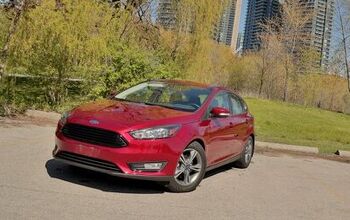Ford Focus EcoBoost 1.0L Review
With the proliferation of its EcoBoost technology and an ongoing battle to be a leader in the fuel economy segment one can’t help but wonder how small of an engine Ford will be willing to offer in its North American lineup.
FAST FACTS
| 1. Ford EcoBoost 1.0L 3-cylinder was recently named International Engine of the Year |
| 2. Fuel Economy is rated at as high as 49 mpg. |
| 3. Set to arrive on our shores, we’re likely to see the EcoBoost 1.0L in the Focus and Fiesta. |
At present, the answer seems to be a 1.0-liter three-cylinder, incorporating direct injection and turbocharging. Developed by Ford’s U.K. technical center in Dunton, Essex, this engine was conceived primarily for powering Ford’s smaller volume vehicles in Europe, namely the Fiesta, Focus and its B-Max and C-Max derivatives.
This week in Dearborn, Ford reaffirmed plans that the EcoBoost 1.0 is definitely coming to North America, though declined to say exactly when (sometime next year was the best we could get), or which cars in its lineup will offer it.
Nevertheless, AutoGuide was given a chance to sample the motor in a Euro-spec Focus at the Dearborn Proving Grounds.
TWO POWER OUTPUTS
In Europe, the Ecoboost 1.0 is currently offered in two versions: one that develops 98 horsepower and the other, 123 horsepower. Availability is currently restricted to the Focus, though Ford says it will be offered in the B-Max and C-Max later this year.
Features of this engine, which is about the size of an A4 sheet of paper, include a low inertia turbocharger, designed to spin at low rpm for better throttle response, while an exhaust manifold cast into the cylinder head has been designed to lower exhaust temperatures and therefore optimize air/fuel ratios across a wider rpm spread.
In addition, in order to maximize efficiency and fuel economy the engine uses a cast-iron instead of aluminum block. The idea is to promote faster warm up, reducing the need for more fuel when cold, thus boosting gas mileage and lowering emissions.
In Europe, the 98-horsepower engine is rated at 4.8-liters per 100 km (49 mpg US), while the 123 hp version is said to deliver 5.0 liters per 100 km (47 mpg US). We should point out, however, that those numbers are based on the less strict European test cycle and should drop by as much as 20 percent once US EPA testing is done. CO2 emissions output is rated at 109 grams per kilometer and 114 g/km respectively.
Because three-cylinder engines are inherently unbalanced and in the past, often incredibly coarse under load (just ask anybody who’s ever driven a Geo Metro), Ford has decided to tackle this issue by installing an unbalanced flywheel, in an effort to improve smoothness without the need to install power robbing balance shafts.
The question is, does it work? Well, during our fairly brief stint driving the car on the track, two things readily became apparent. Firstly, for such a small engine the EcoBoost 1.0 delivers a healthy wallop of torque at low rpm.
Secondly, it feels and sounds very much like a small diesel engine, even though it runs on gasoline. In our six-speed manual test Focus we had no problem accelerating out of corners and traversing hills and dips on the test route. Usually, in a car of this size with a gas engine this small, the thing would have trouble getting out of its own way, yet the EcoBoost 1.0 was responsive, peppy even.
Although not as smooth as its larger 1.6 and 2.0-liter four-cylinder counterparts, it’s far removed from the likes of that nasty old Suzuki unit found in the Geo Metro and is without doubt, an overachiever of an engine. And, like other EcoBoost motors, it’s designed to run on regular grade fuel.
WHAT WILL WE GET IT IN?
At this point it’s difficult to say, though we’ll interpret small cars to mean likely the Focus and possibly the Fiesta too. If and when that does happen, Ford will likely list it as an option on the Focus rather than the standard engine, in keeping with practice on other models such as the Taurus and F-150. That way, consumers will have a chance to warm to it, since after all, the idea of a three-cylinder engine in a regular passenger car is still alien to most Americans.
As to any changes we can expect from the European version, engineers we talked in Dearborn this week said they would be minimal, restricted to minor spark calibrations and ECU settings.
THE VERDICT
Expecting to be underwhelmed, the Ford’s new 1.0L EcoBoost engine surprises with power and is a reassuring sign that the return of the 3-cylinder engine won’t spell a new era of outrageously underpowered cars. Perfectly suitable in terms of power for the Focus, it’s certain to be an even better match in the Fiesta. There’s still more to be done in the area of refinement, while perhaps the biggest potential drawback will be Ford’s strategy of pricing its EcoBoost offerings above the conventional gasoline ones, meaning those interested in this ultra efficient gasoline engine have to settle for its diesel-like characteristics.
LOVE IT
- Throttle response
- Very compact
- Smoother than you’d expect
LEAVE IT
- Long-term durability?
- Four-cylinder still more satisfying to drive
- Will likely come with an EcoBoost premium
More by Huw Evans































Comments
Join the conversation